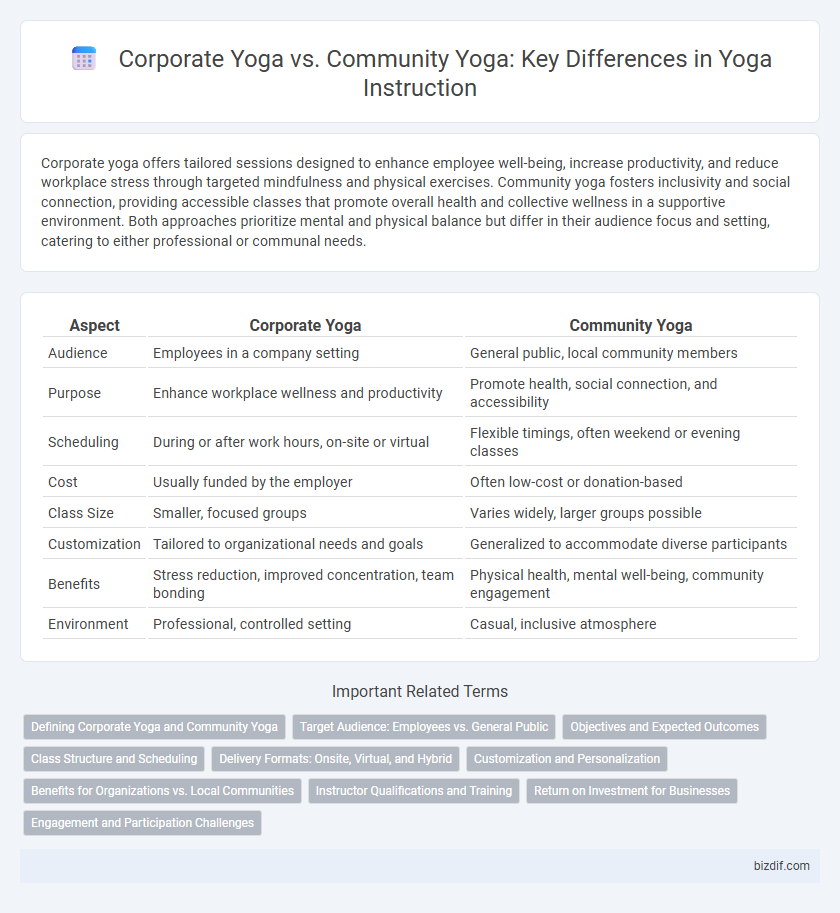Corporate yoga offers tailored sessions designed to enhance employee well-being, increase productivity, and reduce workplace stress through targeted mindfulness and physical exercises. Community yoga fosters inclusivity and social connection, providing accessible classes that promote overall health and collective wellness in a supportive environment. Both approaches prioritize mental and physical balance but differ in their audience focus and setting, catering to either professional or communal needs.
Table of Comparison
| Aspect | Corporate Yoga | Community Yoga |
|---|---|---|
| Audience | Employees in a company setting | General public, local community members |
| Purpose | Enhance workplace wellness and productivity | Promote health, social connection, and accessibility |
| Scheduling | During or after work hours, on-site or virtual | Flexible timings, often weekend or evening classes |
| Cost | Usually funded by the employer | Often low-cost or donation-based |
| Class Size | Smaller, focused groups | Varies widely, larger groups possible |
| Customization | Tailored to organizational needs and goals | Generalized to accommodate diverse participants |
| Benefits | Stress reduction, improved concentration, team bonding | Physical health, mental well-being, community engagement |
| Environment | Professional, controlled setting | Casual, inclusive atmosphere |
Defining Corporate Yoga and Community Yoga
Corporate Yoga refers to structured yoga sessions designed specifically for employees within a workplace, aiming to reduce stress, enhance productivity, and promote overall well-being on the job. Community Yoga, in contrast, involves accessible group classes held in public or shared spaces, fostering social engagement and inclusivity among diverse participants. Both forms emphasize physical and mental health benefits but differ primarily in setting, audience, and organizational goals.
Target Audience: Employees vs. General Public
Corporate yoga sessions cater specifically to employees within organizations, aiming to improve workplace wellness, reduce stress, and boost productivity. Community yoga classes target the general public, providing accessible health and mindfulness benefits to a diverse range of participants. Employee-focused programs often include tailored schedules and private sessions while community yoga emphasizes inclusivity and social engagement.
Objectives and Expected Outcomes
Corporate yoga targets enhancing employee well-being, reducing workplace stress, and boosting productivity through tailored sessions that improve focus and physical health. Community yoga emphasizes inclusivity, social connection, and collective wellness, aiming to foster mental resilience and accessibility for diverse populations. Both forms promote mindfulness and physical fitness but differ in setting-specific goals and engagement strategies.
Class Structure and Scheduling
Corporate yoga classes typically feature concise, 30 to 45-minute sessions tailored to fit within lunch breaks or before/after work hours, emphasizing stress relief and posture correction for office-related ailments. Community yoga sessions often run longer, around 60 to 90 minutes, allowing for varied class structures including beginner, intermediate, and specialty classes that accommodate diverse schedules and fitness levels. Scheduling for corporate yoga prioritizes convenience and consistency to integrate seamlessly into the workday, whereas community yoga offers flexible timing to attract a broader demographic with varied availability.
Delivery Formats: Onsite, Virtual, and Hybrid
Corporate Yoga sessions often utilize hybrid and virtual delivery formats to accommodate busy professionals and remote work environments, enhancing accessibility and flexibility. Community Yoga classes typically emphasize onsite experiences in local studios or parks, fostering social interaction and a stronger group dynamic. Both formats benefit from technology integration, but corporate settings prioritize efficient scheduling and personalized engagement through digital platforms.
Customization and Personalization
Corporate Yoga programs offer tailored sessions designed to address specific workplace stressors and improve employee well-being, often incorporating schedule flexibility and targeted breathwork techniques. Community Yoga classes emphasize inclusivity and adaptability for diverse skill levels, promoting holistic health through group settings and culturally relevant practices. Personalization in Corporate Yoga is business-centric, while Community Yoga prioritizes accessible modifications to meet individual physical needs.
Benefits for Organizations vs. Local Communities
Corporate Yoga enhances employee productivity, reduces workplace stress, and decreases absenteeism, leading to improved organizational performance and team cohesion. Community Yoga fosters social inclusion, supports mental health, and promotes overall well-being among diverse local populations, strengthening community bonds. Organizations benefit from targeted wellness programs that improve employee engagement, while local communities gain accessible resources that encourage healthy lifestyles for all age groups.
Instructor Qualifications and Training
Corporate yoga instructors typically possess specialized certifications in workplace wellness and ergonomic movement to tailor sessions for employee needs, enhancing productivity and stress management. Community yoga instructors often hold broader certifications such as RYT 200 or 500, emphasizing inclusivity and adaptability for diverse groups and varying skill levels. Both require ongoing training to stay updated on best practices, but corporate yoga demands knowledge of corporate culture and health policies, while community yoga prioritizes accessibility and community engagement.
Return on Investment for Businesses
Corporate Yoga programs demonstrate a higher Return on Investment (ROI) for businesses by reducing employee stress levels, increasing productivity, and decreasing absenteeism. In contrast, Community Yoga offers broader accessibility and social benefits but lacks the targeted workplace wellness metrics that directly enhance business performance. Investing in Corporate Yoga yields measurable improvements in employee engagement and overall organizational efficiency, making it a strategic choice for companies seeking tangible ROI.
Engagement and Participation Challenges
Corporate Yoga programs often face engagement challenges due to employees' busy schedules and varying fitness levels, leading to inconsistent participation rates. Community Yoga classes tend to attract more committed participants through a shared sense of purpose and social interaction, fostering higher attendance and sustained involvement. Addressing barriers such as time constraints and motivation in corporate settings requires customized scheduling and incentivized participation strategies to enhance engagement.
Corporate Yoga vs Community Yoga Infographic

 bizdif.com
bizdif.com